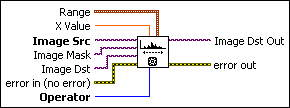IMAQ MathLookup VI
Owning Palette: ProcessingInstalled With: NI Vision Development ModuleConverts the pixel values of an image by replacing them with values from a defined lookup table. This VI modifies the dynamic range of either part of an image or the complete image, depending on the type of curve chosen.




 |
Range is a cluster containing the minimum and maximum pixel values of the range to modify. If you do not connect this cluster or you keep the default values of (0,0), the VI modifies the dynamic range of the entire image. The dynamic range of the destination image is dependent on the type of input image. The dynamic range for an 8-bit image is between 0 and 255. The dynamic range for 16-bit and floating-point images is the smallest and largest pixel value contained in the original image before processing.
|
||||||||||||||||
 |
X Value is a value used only for the operators Power X and Power 1/X. |
||||||||||||||||
 |
Image Src is a reference to the source image. |
||||||||||||||||
 |
Image Mask is an 8-bit image that specifies the region of the small image that will be copied. Only those pixels in the Image Src (Small) image that correspond to an equivalent non-zero pixel in the mask image are copied. All other pixels keep their original values. The entire image is processed if Image Mask is not connected. |
||||||||||||||||
 |
Image Dst is a reference to the destination image. |
||||||||||||||||
 |
error in (no error) describes the error status before this VI or function runs. The default is no error. If an error occurred before this VI or function runs, the VI or function passes the error in value to error out. This VI or function runs normally only if no error occurred before this VI or function runs. If an error occurs while this VI or function runs, it runs normally and sets its own error status in error out. Use the Simple Error Handler or General Error Handler VIs to display the description of the error code. Use error in and error out to check errors and to specify execution order by wiring error out from one node to error in of the next node.
|
||||||||||||||||
 |
Operator specifies the remapping procedure to use. The horizontal axis represents the pixel values before processing (between Minimum and Maximum), and the vertical axis represents the pixel values after processing. The default is Linear. You can choose from the following valid operators:
|
||||||||||||||||
 |
Image Dst Out is a reference to the destination image. If Image Dst is connected, Image Dst Out is the same as Image Dst. Otherwise, Image Dst Out refers to the image referenced by Image Src. |
||||||||||||||||
 |
error out contains error information. If error in indicates that an error occurred before this VI or function ran, error out contains the same error information. Otherwise, it describes the error status that this VI or function produces. Right-click the error out indicator on the front panel and select Explain Error from the shortcut menu for more information about the error.
|
Examples
Refer to the following for an example that uses this VI.
- LabVIEW\examples\Vision\2. Functions\Grayscale Processing\MathLookup Example.vi






